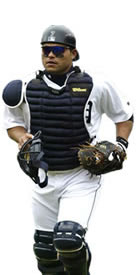Catchers: Tips, Drills, Information, Catching Equipment, Catchers Gear |
||||
Baseball-Catcher.com |
||||
Guide for Catchers |
||||
|
Basic Skills Stance Setting Up Receiving Framing Blocking Throwing Leadership In-depth Skills Relays, Cutoffs, and Plays at Home Signals Calling A Game Catching Bullpens Covering Bases Pre-Game Routine Umpire Rapport Misc. Situations and Plays |
 Job of the CatcherThe catcher has the most thankless job on the field, but yet, is the most important position besides the pitcher. As a catcher you are involved in every single play. You are the conductor of an orchestra and the players on the field are your instruments. A catcher has a number of responsibilities, each one just as important as the other; signaling pitches, relaying plays and bunt coverage, blocking wild pitches, and throwing out runners attempting to steal are only a few.As a catcher, you need to be aware of everything on the field and you need to know what to do in every possible situation. For example, you need to know: What is the score? How many outs are there? What is the count? What type of hitter is up (his tendencies.can he hit a curveball)? Who's on deck and what type of hitter is he? What pitch should I call next? Is the defense set? What about base runners? Are they fast? If the ball is hit to the gap where is the relay supposed to go? Is there a possible play at home? These questions and others need to be answered on every single pitch. This may seem like a lot to think about, especially to players just starting to learn the position, but with practice, experience, good coaching, and this tutorial, the answers to these questions will become second nature.
|
 OnBaseball.com | ||